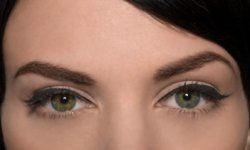About 18 million women are more stressed out by facial hair (their own, not their partners') than they are about finances, according to a poll by research firm Kelton Global. [Source: Azam] In addition to fuzz on their upper lips and hair on their chinny-chin-chins, this also includes the dreaded unibrow -- or, at the very least, unruly stray strands between and around the eyebrows, just begging to be removed.
Many women (and some men) choose to pluck their eyebrows into submission, while others opt for an ancient procedure, recently made popular again at salons, known as threading. But eyebrow waxing -- a process by which a hot strip of wax is applied to the skin and ripped off, hairs included, once it dries -- is still a tried and true method of quick and easy hair removal. For many people, waxing is the best option; for others, however, it can cause breakouts and skin irritation.
Advertisement
"When you wax your eyebrows or any other part of your body, that liquid wax is applied to the entire skin surface," explains Chris Adigun, MD, assistant professor of dermatology at NYU Langone Medical Center in New York City. "That means that when you rip it off, that top superficial layer of skin is removed with it, along with the hair." People with sensitive skin or people who are using topical acne medications are more at risk for complications, she adds.
When waxing is done at a salon, it's important to make sure that the aesthetician uses a new applicator for each session; reusing applicators makes it possible for germs to spread and can contribute to bacterial infections that resemble breakouts. [Source: FoxNews.com] You can also wax your own eyebrows using an at-home kit, but it's still important to follow all instructions and keep all materials clean before and during use. (Waxing can also cause burns if the wax is heated up too high, and can cause injury if it's applied to the eyelids where the skin is extremely thin.)
Waxing should last about two weeks or more, since the entire hair is being removed (rather than just the hair on the surface, as with shaving). That's good news, says Adigun, because the more frequently you wax, the more irritated your skin will get. If you find that even occasional waxing causes you to break out, consider plucking or threading, instead.
Advertisement
